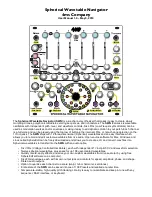
TRAX RetroWave Owner’s Manual
< 17 >
Triangle
The triangle wave has only odd harmonics, and
sounds much less harsh to the ear than either the square or
reverse sawtooth. It is very useful for flute-like sounds and
whistle effects.
Sine
The sine wave has no harmonics at all, and is
consequently the blandest of all the waveforms the RS-1
offers. However, it has its uses, and is particularly effective
when swept by an ADSR waveform, to give some classic
synth drum effects, or bass lines that can be “felt” rather
than heard!
TUNE
The
TUNE
control allows you to shift the basic tuning from A (440Hz) by a little over 1.5 octaves, up or
down. This is useful when tuning the unit to other instruments, or the control can be used to make subtle
changes to the oscillator frequency while playing.
Octave Selector Switch
Below and to the right of the
TUNE
control there is a toggle switch, for shifting the tuning range either up
or down by one full octave, useful if you are using a small MIDI keyboard with a restricted range. It can
also be used while playing to give a rapid pitch shift effect.
MIDI CV Routing Switch
This allows you to send the MIDI CV to the VCO alone (upper position), the VCO and the VCF together
(lower position), or to neither (centre off position). The latter is useful if you wish to send external control
voltages to the VCO and VCF, without the MIDI CV offsetting the VCO pitch and VCF cutoff frequency.
FM Sources
These
controls, all of which can be freely mixed, determine how much
frequency modulation
is applied to
the VCO control voltage inputs from
LFO 1, LFO 2, SAMPLE & HOLD
and
ADSR
sections respectively,
q.v.
The
LFO 1
and
LFO 2
controls are used to provide vibrato effects, adding subtlety to a keyboard
performance, or they can be used to obtain extreme modulation (think techno!). Mixing the outputs of the
two creates unique programming wave shapes that give unpredictable and interesting siren effects and
weird other-worldly sounds.
SAMPLE & HOLD
This circuit applies random voltages to the VCO. The output level of the white noise generator is
“sampled” at intervals determined by
LFO 1
’s square wave output to give random control voltages, which
are useful for random note effects. The further the S & H level control is turned clockwise, the wider the
pitch range of the notes produced. Good for creating a “psycho” feel in a keyboard solo.
































